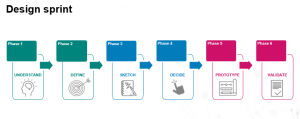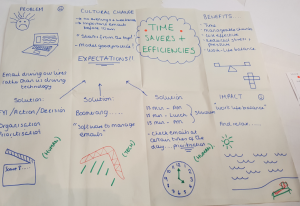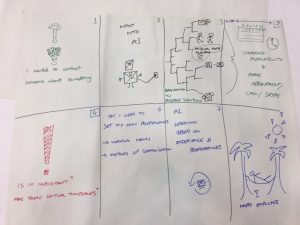At the recent Digifest conference we ran a digital wellbeing design sprint session. This one-hour workshop was aimed as an introduction to the design sprint methodology and incorporated a focus on a particular wellbeing issue experienced by many, ‘email overload’. We thought that combining the design sprint and an issue in the digital wellbeing space would bring interesting ideas and solutions – and we were right!
What is a design sprint?
Design sprint is a process used for developing new products or services. It was developed at Google and is now being used and adapted in many organisations. A design sprint is a great way to get a cross institutional team in one place (usually these sprints last around 3-5 days), maximise learning and reduce failure rate when launching a new product or service. The sprint framework gives an easy way to navigate the six phases of the process (ranging from understanding the problem to validating a prototype with users).
Workshop
To give our attendees a real flavour of the design sprint in the very limited time available we concentrated on the process from understanding the problem to generating ideas and then creating a storyboard for the solution. We didn’t have time to do the prototyping and validation with users – but we still got some great results!
Not surprisingly it seemed that all our participants were familiar with the issue of email overload. In order to understand and define the problem however, we used a simple technique of asking a series of questions using the five W’s and one H (5W1H: who, what, where, when, why, how).
We then moved on to the individual work sketching ideas and solutions to the problem. Having shared the ideas within their groups the delegates created a heat map of best solutions and worked collaboratively on creating the best solution to the email overload problem. The solution was then presented in a format of a storyboard.
Here is a couple of the storyboards from the workshop. You can find the rest on Twitter #dwsprint.
We ended the session with a brief overview of a digital wellbeing project that the Student experience team in Jisc are just starting. This project aims to:
- establish a shared vocabulary around digital wellbeing
- review digital wellbeing activities in colleges and universities and what role or roles the organisation has in supporting their staff and students in this area
- share examples of good practices
- identify any gaps there are with the view to see what might be done to address them.
We would like to thank everyone who came along to the workshop for their enthusiastic contributions. It was great to see so much interest in the design sprint method!
Find out more
If you would like to have a go at running a design sprint yourself we recommend having a look at the “Sprint – how to solve big problems and test new ideas in just five days” book by Jake Knapp, John Zeratsky and Branden Kowitz; and also the Design Sprint Kit.
If you would like to keep in touch with the developments around the digital wellbeing project in Jisc you can join the project mailing list.




